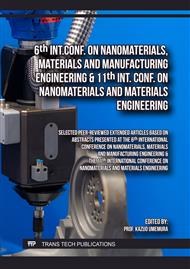[1]
Imam M.A., F.H. Froes and K.L. Housley: Kirk‐Othmer Encyclopedia of Chemical Technology, 5th edn (Wiley, 2010).
DOI: 10.1002/0471238961
Google Scholar
[2]
A.U. Saudi, M. Wibisono, W. Rianti, B. Triwibowo and I.N. Jujur: AIP Conf. Proc., Vol. 2663, 050008 (2022).
DOI: 10.1063/5.0108289
Google Scholar
[3]
C. Sutowo, S. Supriadi, A.W. Pramono and B. Suharno: East.-Eur. J. Enterp. Technol., Vol. 1, 30–37 (2020).
DOI: 10.15587/1729-4061.2020.193932
Google Scholar
[4]
M.D. Richardson: Microstructural and Mechanical Property Development in Metastable Beta Titanium Alloys (University of Sheffield, 2016) https://etheses.whiterose.ac.uk/12663/ (accessed 15 Jan 2023).
Google Scholar
[5]
G. Shun, M. Qingkun, Z. Xinqing, W. Qiuming and X. Huibin: Sci. Rep., Vol. 5 (2015).
DOI: 10.1038/srep14688
Google Scholar
[6]
H. Shinzing, Z. Qinyang, W. Cong, L. Cheng and M. Chengliang: J. Alloys Compd., Vol. 876 (2021).
DOI: 10.1016/j.jallcom.2021.160085
Google Scholar
[7]
N.A. Al-Mobarak, A.A. Al-Swayih and F.A. Al-Rashoud: Int. J. Electrochem. Sci., Vol. 6, 2031–42 (2011).
DOI: 10.1016/S1452-3981(23)18165-X
Google Scholar
[8]
M. Sarraf, E.R. Ghomi, S. Alipour, S. Ramakrishna and N.L. Sukiman: Bio-Des. Manuf., Vol. 5, 371–95 (2022).
DOI: 10.1007/s42242-021-00170-3
Google Scholar
[9]
J.D. Cotton, L.P. Clark and H.R. Phelps: JOM, Vol. 58, 13–16 (2006).
DOI: 10.1007/S11837-006-0172-Z
Google Scholar
[10]
R. Dąbrowski: Arch. Metall. Mater., Vol. 56, 217–22 (2011).
DOI: 10.2478/v10172-011-0025-9
Google Scholar
[11]
D. Damisih, I.N. Jujur, J. Sah and D.H. Prajitno: Widyariset, Vol. 4, 153–62 (2018).
DOI: 10.14203/widyariset.4.2.2018.153-162
Google Scholar
[12]
S. Cummings: Microstructure and Mechanical Properties of Titanium Alloys in Biomedical Application (University of Queensland, 2017) https://core.ac.uk/download/pdf/156876734.pdf (accessed 20 Mar 2023).
Google Scholar
[13]
G. Lutjering, J.C. Williams and A. Gysler: Microstructure and Mechanical Properties of Titanium Alloys, Vol. 2 (World Scientific, 2000).
DOI: 10.1142/4311
Google Scholar
[14]
L. Thair, U.K. Mudali, R. Asokamani and B. Raj: Mater. Corros., Vol. 55, 358–66 (2004).
DOI: 10.1002/MACO.200303724
Google Scholar
[15]
S. Tamilselvi, V. Raman and N. Rajendran: Electrochim. Acta, Vol. 52, 839–46 (2006).
DOI: 10.1016/J.ELECTACTA.2006.06.018
Google Scholar
[16]
T. Sercombe, N. Jones, R. Day and A. Kop: Rapid Prototyp. J., Vol. 14, 300–4 (2008).
DOI: 10.1108/13552540810907974
Google Scholar
[17]
S.A. Ajeel, T.L. Alzubaydi and A.K. Swadi: J. Eng. Technol., Vol. 25, 431–42 (2007) https://www.iasj.net/iasj/article/26050.
Google Scholar
[18]
A. Fityan, S. El-Hadad and W. Khalifa: Ceram. Trans., Vol. 261, 169–77 (2018).
DOI: 10.1002/9781119423829.CH14
Google Scholar
[19]
G. Lütjering and J.C. Williams: Titanium, 2nd edn (Springer, Berlin, 2007) https://link.springer.com/book/.
DOI: 10.1007/978-3-540-73036-1
Google Scholar
[20]
M.S. Kalienko, A.V. Zhelnina, A.V. Volkov and P.E. Panfilov: Russ. Metall. (Metally), Vol. 2022, 1211–7 (2022).
DOI: 10.1134/S003602952210010X
Google Scholar
[21]
N. Singh, S. Acharya, K.G. Prashanth, K. Chatterjee and S. Suwas: J. Mater. Res., Vol. 36, 3691–700 (2021).
DOI: 10.1557/S43578-021-00238-X
Google Scholar
[22]
M.W. Wu, J.K. Chen, M.K. Tsai, S.H. Wang and P.H. Lai: Mater. Lett., Vol. 286, 129198 (2021).
DOI: 10.1016/J.MATLET.2020.129198
Google Scholar
[23]
P. Bocchetta, L.Y. Chen, J.D.C. Tardelli, A.C. Dos Reis and P. Leo: Coatings, Vol. 11, 487 (2021).
DOI: 10.3390/COATINGS11050487
Google Scholar
[24]
E. Kobayashi, T.J. Wang, H. Doi, T. Yoneyama and H. Hamanaka: J. Mater. Sci. Mater. Med., Vol. 9, 567–74 (1998).
Google Scholar
[25]
M. Atapour, A. Pilchak, G.S. Frankel, J.C. Williams and M. Shamanian: Corrosion, Vol. 66, 065004-9 (2010).
DOI: 10.5006/1.3452400
Google Scholar



